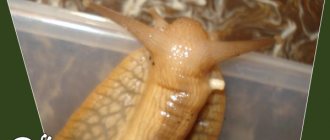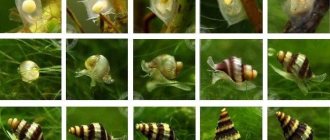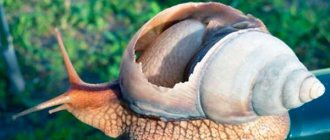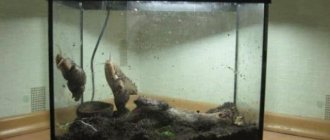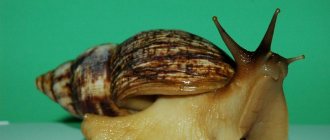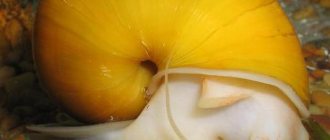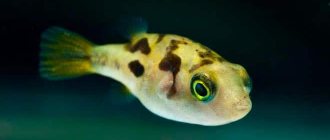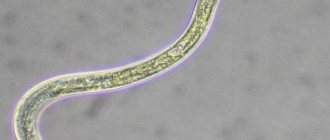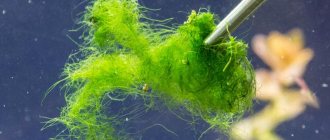Snails
Simplicity of content:
Latin name: Planorbidae
Lifespan: 2.5 years
Maximum size: 1.5-3.5 cm.
Average cost: 10 rub.
There are aquarists who deliberately breed snails and there are several reasons for this - they like their external qualities, as food for predatory fish, to clean the aquarium (the last option is the most common). However, often this “guest” appears unexpectedly and becomes extremely unwanted. You can introduce mollusks in the form of eggs with new plants (the clutches can be on the leaves) or you can plant a few out of ignorance. Such animals can be useful for the underwater world, but most often they try to get rid of them by all available means, which does not always work.
Coil appearance
The coil snail is a freshwater pulmonary gastropod that lives in natural conditions in reservoirs with moderate currents and a large number of plants. Their survival rate is simply amazing, snails can adapt to the most aggressive conditions , and they are able to obtain the oxygen necessary for life from both water and air. They tolerate any temperature conditions. If living conditions are unfavorable, the snails hibernate.
External view of the snail coil.
The shell resembles a spiral, which can consist of from 4 to 8 curls, as a rule, each curl is thicker than the previous one. The shell is translucent, so you can see the structure of the body. The bulk of the body mass is the shell, which accounts for 91%.
The coil stores a small amount of air, which helps, if necessary, to rise to the top of the aquarium or sink to the bottom. Color can vary from rich red to dark brown. A sexually mature individual reaches a size of 4 cm in nature, but in an aquarium it does not grow more than 1.5 cm.
Movement is carried out using a wide flat leg. Movements are smooth, slow. Moving on the surface of the water is impossible, since an insufficient amount of mucus is produced for such processes.
Respiratory processes are carried out by the lung, located inside the shell and occupying the most space. On the head you can see tentacles and small horns. The coil has organs of vision, but it is weak and all they can see is to distinguish day from night.
Duration in aquarium conditions is about 2.5 years.
Description of the species
The reels breathe with their lungs and are forced to rise to the surface of the water for a breath of air.
They also carry a bubble of air in their shell, which they use as ballast - in order to float up or, conversely, quickly sink to the bottom. Coils last about two years, or even longer. Most types of coils living in an aquarium grow no more than a centimeter in size. They tolerate low-salt water quite well, which makes them good companions for some types of fish. For some fish, for example, tetradons, reels are their favorite food.
The fact is that their shell is not very hard and is quite easy to bite through. Coils are even specially raised to feed fish, or, on the contrary, snail exterminators are bred to destroy them in a common aquarium.
Coils last from a year to two, rarely more. It is often difficult to understand whether the coil has already died or is simply resting. In this case, you need to... smell it. The deceased quickly decomposes and has a strong smell. No matter how strange it may sound, it is important to control the death of snails, especially in small aquariums. The fact is that they can completely spoil the water, as they quickly begin to decompose.
The snail is a representative of freshwater mollusks. In nature, they live in overgrown reservoirs with weak currents. It is adapted to survive even in very dirty bodies of water with low oxygen content in the water. This ability is due to the presence of a kind of lungs that allow her to breathe atmospheric air.
The snail's shell resembles a flat, tightly wound spiral. There are usually four to five whorls, with each subsequent whorl thickening. The seam between the turns is clearly visible on both sides. The mollusk can reach sizes up to 3.5 centimeters in diameter, but most often in an aquarium, coils grow only up to 1 centimeter. By the way, the larger the snail population, the smaller they will be.
The body color can vary from brown to bright red, depending on the type of coil. The mollusk moves with the help of a leg with a wide flat base-sole. Thin long horns are visible on the head.
The snail can also move along the surface of the water, turning its shell down - this ability occurs due to the air bubble that is located in the shell. In case of danger, she immediately releases this bubble and falls to the bottom. Newborn small snails usually stick together, clinging to aquarium plants.
Reproduction
The coil is a hermaphrodite that can self-fertilize and further reproduce. Therefore, if you want to get a population of these snails, then you will only need to have a couple of individuals. The snail lays eggs on the inside of a leaf of an aquarium plant.
Basically, the population of snails in aquariums is regulated without the intervention of the aquarist, since aquarium fish happily eat young snails. But if the fish are full, then they won’t particularly touch small shellfish. If you notice a rapid increase in the snail population, this indicates that you are overfeeding your fish. Therefore, you just need to cut down the rations for the fish and use your hands to remove the snails from the jar.
There are cases when aquarists purposefully breed snails because they are used as food for some pets or fish (bots). In this case, there is no need to pour soil into the aquarium, as this will complicate the process of cleaning the aquarium. Place several types of floating plants (naiad, pistia, riccia, Java moss) in a jar.
The coil snail is one of the few domestic inhabitants that can be found in the reservoirs of our country. In their natural habitat, mollusks prefer reservoirs with fresh standing water or rivers with a slow flow. Most often, representatives of this species can be found in places where rotten algae accumulates, which is their favorite delicacy.
We suggest you read: Why do the stones turn green in the aquarium?
Representatives of this species have a shell of a classic round shape, with several turns, which helps them adapt to almost any living conditions. An adult mollusk can reach a size of up to 3 centimeters in length, and most often has a light-colored shell.
Many breeders keep representatives of this species as indicators of water quality and lack of oxygen in the aquarium. If the snails float closer to the top layer of water, then it’s time to replace it. This behavior of snails is explained by the presence of lungs, with which this mollusk can breathe atmospheric air.
Kinds
In captivity, horned and horned red snails are popular. However, you should not think that this is the end of their diversity, because there are a large number of them. Each species has its own characteristics in appearance.
Horny
Perhaps the largest representative of reels. Constantly found in thickets of plants, lives mainly at the bottom of the aquarium. This is due to the fact that the mollusk has a very weak jaw, and the soft food necessary for life can be found in the ground. They can eat decomposed fish food, dead leaves of plants, and dead fish. The size is about 3.5 cm, no more than 5 turns can be seen on the shell.
Horny red
This type, unlike the previous one, is smaller in size - 2 cm. As the name suggests, the shell has a red tint. Many experienced aquarists note that horny red snails are the best at cleaning the aquarium; in addition, they perform decorative functions (the red color looks very interesting in combination with green plants). The advantage is that once the coils have destroyed all the sediment in the soil, it does not transfer to the plants.
Far Eastern
A distinctive feature from other varieties is the wavy lines on the shell, otherwise it is completely similar to its relatives. Unpretentious in care and maintenance. In nature, it lives mainly in swamps.
Keeled
A representative of the underwater world, most often found in aquariums. These snails can be brought in with new plants, nutrient substrate, or soil. It has a brown shell, a diameter of about 2 cm, while the width rarely reaches 0.5 cm. This name was obtained due to the presence of an interesting seam, which is located along the entire outer side; visually it may seem as if it divides the coil into two identical ones parts. Plant debris and algae on the walls of the aquarium are suitable as food for snails.
Wrapped
A distinctive feature is the almost transparent shell, which has a dirty yellow color, the diameter reaches up to 1 cm. The wrapped snail is considered the most important pest that you can encounter in an aquarium. Because it reproduces frequently and is fertile. In a short period of time they will fill everything around. This, as a rule, leads to damage to water and nutrient soil, and the appearance does not look more attractive.
What is more, benefit or harm?
It is impossible to give a definite answer whether coils are harmful or beneficial for the aquarium. On the one hand, they are able to bring benefits by cleaning the aquarium, but on the other hand, uncontrolled abundant reproduction can cause quite a lot of problems. In addition, getting rid of them is not as easy as it might seem at first.
The benefits of coils
The benefits are as follows:
- an excellent option for decoration, because thanks to the coils the aquatic world is transformed, becoming as close to natural as possible;
- water orderlies . Reels use food leftovers from fish as food, eat dead plant leaves, and are able to completely utilize dead small fish;
- The snail serves as a kind of indicator; you can use them to navigate when the aquarium needs cleaning. For example, if their population increases sharply, this indicates a large amount of food in the soil - a siphon and water change are immediately required; if the snails have risen from the bottom to the surface, then there is a deficiency of oxygen in the water and the functionality of the air compressor must be urgently checked;
- some grow reels to feed fish. Thanks to the rapid reproduction process, you don’t have to worry that predators will experience a shortage of live food;
- Besides this, snails are very interesting to watch.
Harm from coils
Snails can also cause some harm:
- due to rapid reproduction, a high concentration of waste products and organic matter is formed in the water, as a result of which water changes will be required more often;
- when there is a nutritional deficiency, some species will happily eat live plants;
- often snails end up in the aquarium, which leads to a bacterial outbreak and infection of other inhabitants.
The colony of coils is growing exponentially. They say it's easier to make coils reproduce than to stop it!
Infection is more likely to occur if the shellfish were taken from an open body of water, however, there are often cases when you can purchase an infected animal at a pet store.
In order to avoid disastrous consequences, it is recommended to quarantine for 1.5-2 weeks after purchasing animals and plants. During this period of time, you can easily understand whether there are sick individuals.
Keeping in an aquarium
For comfortable keeping of coils, an aquarium with a volume of one liter or more is suitable. To prevent the coils from crawling out of the aquarium, it must be covered with a lid.
Soil for snails is not a mandatory element, so you can use whatever you like. But it’s worth planting more live plants - the coils won’t touch them, and the benefits of plants in the aquarium are invaluable.
The water flow in the aquarium should not be strong.
What do the coils feed on?
Snails feed on all sorts of leftovers from aquarium life and the mollusks do not require additional feeding.
The coils feed on decaying organic matter and algae, so finding food in the aquarium will not be a difficult task for them.
Conditions of detention
No special conditions are required to maintain the coils. The optimal water temperature for keeping is in the range of 22-28°C
Reproduction
Coil snails are typical hermaphrodites, that is, each of them has both female and male gonads. For fertilization, only two individuals are sufficient, which cross-exchange reproductive products.
After this, the snail lays eggs on the underside of plant leaves. They look like white dots in a gelatinous cocoon. This cocoon is quite strong and can withstand the pressure of some types of fish.
Depending on the water temperature, incubation of the eggs lasts from 14 to 30 days, after which small snails are born. Their shell is soft, so they can easily become a victim of almost any fish.
Snails reproduce and develop especially actively in aquariums with warm water at 25-28°C and regular overfeeding of fish. A sharp increase in the snail population is a signal to limit fish feeding.
The benefits and harms of coils
Undoubted benefits of shellfish:
- Decorative properties - mollusks add variety to the aquarium and are interesting to watch;
- The reels also serve as orderlies, as they eat dead plant leaves, leftover fish food and algae. This does not damage living plants;
- Often, coils act as indicators of the condition of the aquarium - a rapid increase in their number indicates excessive accumulation of organic matter (overfeeding of fish);
- Reels are valuable food for some species of fish that feed on snails, such as tetraodon.
But there are certain disadvantages to the content of the coils:
- The simple process of reproduction leads to a sharp increase in numbers, which negatively affects the balance in the aquarium;
- A large number of snails spoils the aesthetics of the aquarium;
- Dead snails can degrade water quality.
Rules of care
Since the coils are able to adapt to any conditions, they do not require special care. However, despite this, the optimal temperature range is from +22C to +28C. It is recommended to periodically add calcium to the water; its deficiency will be noticeable by the appearance of the shell. The aquarium must be closed, as the mollusks can crawl out of the water and die.
Sometimes it is difficult to understand whether a snail is alive or dead. To do this, they pull it out and evaluate the smell - the dead one smells of rot. Dead individuals must be removed immediately, as they cause water spoilage.
Reproduction
As practice shows, coil snails are so prolific that there is absolutely no need to create special conditions for their reproduction. These aquarium snails are hermaphrodites, meaning they can fertilize themselves. Thus, if there is at least one coil in the water, then over time it can lay eggs, from which other mollusks will be born, ready for further reproduction and replenishment of their genus.
Coil snail - young coils of different ages.
Once the snail has grown to the desired size, it is ready to reproduce. Many sources indicate that reproduction is possible after the snail is one year old, but in reality everything is completely different and faster, otherwise their population would not be so numerous.
Caviar can be seen on the walls of the aquarium, on the filter, decorative elements, stones, leaves of living plants - sometimes it is almost impossible to see them. Maturation lasts about 10 days, but can take up to a month, but only if the water is cold. As practice shows, the higher the temperature of the water, the faster all processes are carried out.
How to get rid
Excessive coil growth is becoming a serious problem for many aquarists, resulting in so much negativity coming their way. The main reason why the number of shellfish is increasing is overfeeding of fish. Therefore, it is recommended to provide a small amount of food, so hungry fish may start hunting for the reels. In addition, if there is a shortage of food, the snails will be busy searching for food rather than reproducing.
There are the following methods of combating the population of “uninvited” guests:
- Banana peels are lowered to the bottom for several hours. After some time, there will be almost all the snails on it, which will not be difficult to take out along with the peel and throw away. For these purposes, you can use cabbage or lettuce leaves.
- It is recommended to remove adult individuals that are capable of replenishing the genus by hand, and the young will be safely eaten by fish.
- The sucker catfish is an excellent option for extermination, as it will not only compete with them for food, but also destroy egg laying.
- The most popular option to get rid of coils is to get Helen snails, which can wipe out an entire population, regardless of size, in just a few days.
- In the most critical cases, they resort to the use of chemicals. However, we should not forget that the sudden disappearance of shellfish can disrupt the ecosystem. It is necessary to use the preparations strictly according to the attached instructions, otherwise you can destroy not only snails, but also plants, fish, and shrimp. The latter are especially sensitive to snail control chemicals.
Catching reel snails on banana peels.
In order not to increase the population of coils, it is recommended to adhere to the following rules:
- fish should not be overfed;
- the soil must always be clean;
- new plants can withstand up to 2 weeks in quarantine;
- get fish that will happily eat snails - marbled loaches, labeo, tetradon, macrognathus.
The benefits and harms can be fully assessed only after introducing these types of snails. Sure, they can cause damage to the aquarium, but this applies to any large population.
Are coils harmful?
There is a lot of negativity about coils, since they multiply very easily and fill the aquarium. But this only happens if the aquarist overfeeds the fish and the snails have no natural enemies. You can read how to get rid of extra snails in an aquarium by clicking on the link.
They also say that the coil spoils the plants, but this is not true. It’s just that they are often seen on rotting or dead plants and are mistaken for the cause, but in fact they simply eat up the plant.
Their teeth are too weak for them to gnaw a hole in a plant, but they really love something that is already rotting and eat it with joy.
It is known that snails can carry parasites throughout their lives that can infect and even kill fish. But this is in nature, and in an aquarium the chance of transmitting parasites with snails is much lower than with food.
Even in frozen food, not to mention live food, various parasites and pathogens can survive.
So I wouldn't worry about it.
If it is very important for you to have snails, but you are afraid of bringing parasites, then you can bring coil eggs, which are not carriers, into the aquarium.

